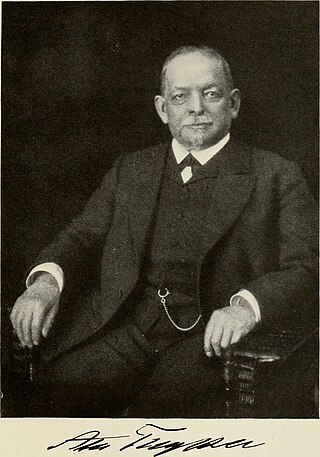
The Krupp family was a prominent 400-year-old German dynasty from Essen, noted for its production of steel, artillery, ammunition and other armaments. The family business, known as Friedrich Krupp AG, was the largest company in Europe at the beginning of the 20th century, and was the premier weapons manufacturer for Germany in both world wars. Starting from the Thirty Years' War until the end of the Second World War, it produced battleships, U-boats, tanks, howitzers, guns, utilities, and hundreds of other commodities.

A cartel is a group of independent market participants who collude with each other in order to improve their profits and dominate the market. A cartel is an organization formed by producers to limit competition and increase prices by creating artificial shortages through low production quotas, stockpiling, and marketing quotas. Cartels can be vertical or horizontal but are inherently unstable due to the temptation to defect and falling prices for all members. Additionally, advancements in technology or the emergence of substitutes may undermine cartel pricing power, leading to the breakdown of the cooperation needed to sustain the cartel. Cartels are usually associations in the same sphere of business, and thus an alliance of rivals. Most jurisdictions consider it anti-competitive behavior and have outlawed such practices. Cartel behavior includes price fixing, bid rigging, and reductions in output. The doctrine in economics that analyzes cartels is cartel theory. Cartels are distinguished from other forms of collusion or anti-competitive organization such as corporate mergers.
The Union Banking Corporation (UBC) was a banking corporation in the US. Founding member and one of its seven directors was Prescott Bush. The banks assets were seized by the United States government on October 20, 1942, during World War II under the U.S. Trading with the Enemy Act and Executive Order No. 9095.

Friedrich "Fritz" Thyssen was a German businessman, born into one of Germany's leading industrial families. He was an early supporter of the Nazi Party, but later broke with them.
Outokumpu Oyj is a group of international companies headquartered in Helsinki, Finland, employing 10,600 employees in more than 30 countries. Outokumpu is the largest producer of stainless steel in Europe and the second largest producer in the Americas. Outokumpu also has a long history as a mining company, and still mines chromium ore in Keminmaa for use as ferrochrome in stainless steel. The largest shareholder of Outokumpu is the Government of Finland, with 26.6% ownership, including the shares controlled by Solidium, The Social Insurance Institution of Finland, Finnish State Pension Fund and Municipality Pension Agency.

ThyssenKrupp AG is a German industrial engineering and steel production multinational conglomerate. It is the result of the 1999 merger of Thyssen AG and Krupp and has its operational headquarters in Duisburg and Essen. The company claims to be one of the world's largest steel producers, and it was ranked tenth-largest worldwide by revenue in 2015. It is divided into 670 subsidiaries worldwide. The largest shareholders are Alfried Krupp von Bohlen und Halbach Foundation and Cevian Capital. ThyssenKrupp's products range from machines and industrial services to high-speed trains, elevators, and shipbuilding. Subsidiary ThyssenKrupp Marine Systems also manufactures frigates, corvettes, and submarines for the German and foreign navies.
S. G. Warburg & Co. was a London-based investment bank. It was listed on the London Stock Exchange and was once a constituent of the FTSE 100 Index. The firm was acquired by the Swiss Bank Corporation in 1995 and ultimately became a part of UBS.

The Thyssen family has notable members, all of whom descend from Friedrich Thyssen, who have established steel works, elevators and escalators, industrial conglomerates, banks, and art collections - Thyssen AG, ThyssenKrupp and ThyssenKrupp Marine Systems. Originating from Germany, family members have taken up residence in various countries.

August Thyssen was a German industrialist.
Heinrich Thyssen, after 22 June 1907 Heinrich, Baron Thyssen-Bornemisza de Kászon et Impérfalva, was a German-Hungarian entrepreneur and art collector.

Until the early 19th century, Germany, a federation of numerous states of varying size and development, retained its pre-industrial character, where trade centered around a number of free cities. After the extensive development of the railway network during the 1840s, rapid economic growth and modernisation sparked the process of industrialization. The largest economy in Europe by 1900, Germany had established a primary position in several key sectors, like the chemical industry and steel production. High production capacity, permanent competitiveness and subsequent protectionist policies fought out with the US and Britain were essential characteristics.
Estel was a steel company formed by the merging of Koninklijke Hoogovens IJmuiden steel plant and Hoesch's main steel plant in Dortmund. The company existed from 1972 to 1982 until de-merged.
The Freundeskreis der Wirtschaft, or Circle of Friends of the Economy was a group of German industrialists whose aim was to strengthen the ties between the Nazi Party and business and industry. The group was formed and co-ordinated by Wilhelm Keppler, one of Adolf Hitler's close economic advisors.
Before 1800 A.D., the iron and steel industry was located where raw material, power supply and running water were easily available. After 1950, the iron and steel industry began to be located on large areas of flat land near sea ports. The history of the modern steel industry began in the late 1850s. Since then, steel has become a staple of the world's industrial economy. This article is intended only to address the business, economic and social dimensions of the industry, since the bulk production of steel began as a result of Henry Bessemer's development of the Bessemer converter, in 1857. Previously, steel was very expensive to produce, and was only used in small, expensive items, such as knives, swords and armor.

Emil Kirdorf was a German industrialist, one of the first important employers in the Ruhr industrial sectors. He was personally awarded by Adolf Hitler the Order of the German Eagle, Nazi Germany's highest distinctions, on his 90th birthday in 1937, for his support to the Nazi Party in the late 1920s.

Thyssen was a major German steel producer founded by August Thyssen. The company merged with Friedrich Krupp AG Hoesch-Krupp to form ThyssenKrupp in 1999.

The Vereinigte Stahlwerke AG was a German industrial conglomerate producing coal, iron, and steel in the interbellum and during World War II.
Salzgitter AG is a German company, one of the largest steel producers in Europe with an annual output of around seven million tonnes.

UBS Group AG is a multinational investment bank and financial services company founded and based in Switzerland. Co-headquartered in the cities of Zürich and Basel, it maintains a presence in all major financial centres as the largest Swiss banking institution and the largest private bank in the world. UBS client services are known for their strict bank–client confidentiality and culture of banking secrecy. Because of the bank's large positions in the Americas, EMEA, and Asia Pacific markets, the Financial Stability Board considers it a global systemically important bank.
Oscar Schlitter was a German banker. Reflecting the long-standing "hands-on" approach of banks in Germany, Schlitter was involved in several major commercial and industrial mergers. He played a leading role in the 1929 merger of the indebted German VGF company with the Dutch ENKA business, creating one of the leading European producers of rayon.










